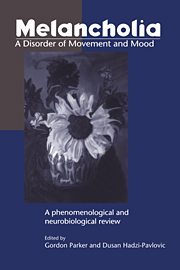Book contents
- Frontmatter
- Contents
- List of contributors
- Acknowledgments
- Introduction
- Part One Classification and Research: Historical and Theoretical Aspects
- Part Two Development and Validation of a Measure of Psychomotor Retardation as a Marker of Melancholia
- 5 Psychomotor Change as a Feature of Depressive Disorders: Historical Overview and Current Assessment Strategies
- 6 Development and Structure of the CORE System
- 7 Reliability of the CORE Measure
- 8 Validity of the CORE: I. A Neuroendocrinological Strategy
- 9 Validity of the CORE: II. Neuropsychological Tests
- 10 Validity of the CORE: III. Outcome and Treatment Prediction
- 11 Phenotypic Expression of Melancholia Contrasted for Those with Bipolar and Unipolar Illness Courses
- 12 Psychotic Depression: Clinical Definition, Status and the Relevance of Psychomotor Disturbance to Its Definition
- 13 A Clinical Algorithm for Defining Melancholia: Comparison with Other Sub-typing Measures
- 14 Rating the CORE: A User's Guide
- Part Three The Neurobiology of Melancholia
- The CORE Measure: Procedural Recommendations and Rating Guidelines
- References
- Author Index
- Subject Index
8 - Validity of the CORE: I. A Neuroendocrinological Strategy
from Part Two - Development and Validation of a Measure of Psychomotor Retardation as a Marker of Melancholia
Published online by Cambridge University Press: 04 August 2010
- Frontmatter
- Contents
- List of contributors
- Acknowledgments
- Introduction
- Part One Classification and Research: Historical and Theoretical Aspects
- Part Two Development and Validation of a Measure of Psychomotor Retardation as a Marker of Melancholia
- 5 Psychomotor Change as a Feature of Depressive Disorders: Historical Overview and Current Assessment Strategies
- 6 Development and Structure of the CORE System
- 7 Reliability of the CORE Measure
- 8 Validity of the CORE: I. A Neuroendocrinological Strategy
- 9 Validity of the CORE: II. Neuropsychological Tests
- 10 Validity of the CORE: III. Outcome and Treatment Prediction
- 11 Phenotypic Expression of Melancholia Contrasted for Those with Bipolar and Unipolar Illness Courses
- 12 Psychotic Depression: Clinical Definition, Status and the Relevance of Psychomotor Disturbance to Its Definition
- 13 A Clinical Algorithm for Defining Melancholia: Comparison with Other Sub-typing Measures
- 14 Rating the CORE: A User's Guide
- Part Three The Neurobiology of Melancholia
- The CORE Measure: Procedural Recommendations and Rating Guidelines
- References
- Author Index
- Subject Index
Summary
Introduction
In a recent review, Rush and Weissenburger (1994) concluded: “Further research is needed to empirically test the biological and psychological features associated with melancholic depression.” In this chapter, we examine the dexamethasone suppression test (DST) as a biological validator of melancholia as defined by the core system. In Chapter 6 we demonstrated quite strong differentiation by DST non-suppression between those assigned by the CORE I system as melancholic and those assigned as non-melancholic, and briefly reported similar differentiation in a sample of the CORE II subjects. Here we also examine DST differentiation in a sample of CORE II subjects, complemented with additional recruitment (beyond closure of that previous study) to ensure a large sample size.
Previous attempts to validate definitions of melancholia (or endogenous depression) against DST results have had mixed outcomes. Whereas the DST appears to discriminate reasonably well between the depressive sub-types defined by the Newcastle Diagnostic Index (Carney, Roth and Garside 1965; Coppen et al. 1983; Holden 1983; Georgotas et al. 1987; Zimmerman et al. 1986c; Staner et al. 1992), there has been much less consistency in its capacity to differentiate rdc and dsm-iii (Davidson et al. 1984; Philip, Maier and Holsboer 1986; Rush and Weissenburger 1994) sub-groups.
Reflecting on the strategy of validating the DST as a marker for melancholia, Zimmerman et al. (1986a) commented: “How does one validate a biological marker of endogenous depression when a valid clinical definition does not exist?”
- Type
- Chapter
- Information
- Melancholia: A Disorder of Movement and MoodA Phenomenological and Neurobiological Review, pp. 138 - 148Publisher: Cambridge University PressPrint publication year: 1996
- 3
- Cited by



